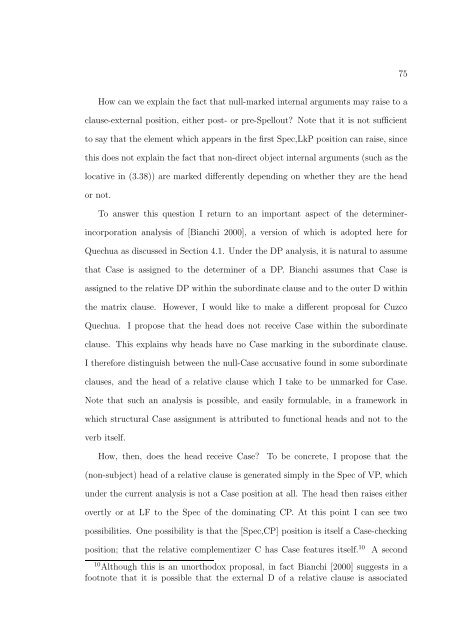the syntax and semantics of relativization and quantification
the syntax and semantics of relativization and quantification
the syntax and semantics of relativization and quantification
You also want an ePaper? Increase the reach of your titles
YUMPU automatically turns print PDFs into web optimized ePapers that Google loves.
75<br />
How can we explain <strong>the</strong> fact that null-marked internal arguments may raise to a<br />
clause-external position, ei<strong>the</strong>r post- or pre-Spellout? Note that it is not sufficient<br />
to say that <strong>the</strong> element which appears in <strong>the</strong> first Spec,LkP position can raise, since<br />
this does not explain <strong>the</strong> fact that non-direct object internal arguments (such as <strong>the</strong><br />
locative in (3.38)) are marked differently depending on whe<strong>the</strong>r <strong>the</strong>y are <strong>the</strong> head<br />
or not.<br />
To answer this question I return to an important aspect <strong>of</strong> <strong>the</strong> determinerincorporation<br />
analysis <strong>of</strong> [Bianchi 2000], a version <strong>of</strong> which is adopted here for<br />
Quechua as discussed in Section 4.1. Under <strong>the</strong> DP analysis, it is natural to assume<br />
that Case is assigned to <strong>the</strong> determiner <strong>of</strong> a DP. Bianchi assumes that Case is<br />
assigned to <strong>the</strong> relative DP within <strong>the</strong> subordinate clause <strong>and</strong> to <strong>the</strong> outer D within<br />
<strong>the</strong> matrix clause. However, I would like to make a different proposal for Cuzco<br />
Quechua. I propose that <strong>the</strong> head does not receive Case within <strong>the</strong> subordinate<br />
clause. This explains why heads have no Case marking in <strong>the</strong> subordinate clause.<br />
I <strong>the</strong>refore distinguish between <strong>the</strong> null-Case accusative found in some subordinate<br />
clauses, <strong>and</strong> <strong>the</strong> head <strong>of</strong> a relative clause which I take to be unmarked for Case.<br />
Note that such an analysis is possible, <strong>and</strong> easily formulable, in a framework in<br />
which structural Case assignment is attributed to functional heads <strong>and</strong> not to <strong>the</strong><br />
verb itself.<br />
How, <strong>the</strong>n, does <strong>the</strong> head receive Case? To be concrete, I propose that <strong>the</strong><br />
(non-subject) head <strong>of</strong> a relative clause is generated simply in <strong>the</strong> Spec <strong>of</strong> VP, which<br />
under <strong>the</strong> current analysis is not a Case position at all. The head <strong>the</strong>n raises ei<strong>the</strong>r<br />
overtly or at LF to <strong>the</strong> Spec <strong>of</strong> <strong>the</strong> dominating CP. At this point I can see two<br />
possibilities. One possibility is that <strong>the</strong> [Spec,CP] position is itself a Case-checking<br />
position; that <strong>the</strong> relative complementizer C has Case features itself. 10<br />
A second<br />
10 Although this is an unorthodox proposal, in fact Bianchi [2000] suggests in a<br />
footnote that it is possible that <strong>the</strong> external D <strong>of</strong> a relative clause is associated
















